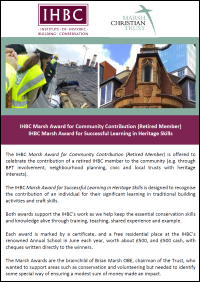The IHBC has welcomed the new edition of Heritage Counts which includes some of the IHBC’s own statistics as well as surveys of over 1000 listed building owners, while IHBC Chair Mike Brown highlighted the importance of those individuals offering the local conservation services that really matter to the public.
IHBC Chair Mike Brown said: ‘Once again we’re delighted to see this rounding off of historic environment statistics collected by and from our sector, and published on our behalf by Historic England. Perhaps the strongest impression we can take from this issue is the wide-ranging pride in our built and cultural heritage. But we must not forget the huge pressures on those individuals and services most directly responsible for its conservation and care, those that do the work that really matters to the public.’
‘Indeed there can be little doubt that the less than impressive statistics around public satisfaction with the country’s historic environment services is closely tied to the devastating and unbalanced slicing through local authority conservation staffing levels over recent years: those people who serve at the front line of the heritage services most valued by the public. And with many authorities now not being able to offer what the IHBC would call a credible conservation service, it’s a relief that the statistics here are not substantially worse.’
‘So the IHBC, and the wider sector and public – including of course the Civic Voice, which has really taken ownership of this core public agenda – can offer a collective thanks to all of those conservation staff for their hard work and success over recent years.’
Highlighting the importance placed on conservation services by the public at large, Craig Mackinlay MP, newly elected Chair of the APPG for Civic Societies, commented ‘As an owner of a listed building, access to expert advice is vital in ensuring that change, in particular through the planning system, is managed in a way that supports what it is that makes places special and heritage assets significant. A lack of access to advice puts local heritage at risk’.
Reflecting that wider concern over conservation staffing levels, The Telegraph has also used the data in Heritage Counts to warn of the impact of staffing cuts around heritage in their article headed ‘Listed buildings at risk from cuts, warns heritage watchdog’, linked below.
Civic Voice writes:
The owners of England’s listed residential buildings say they feel privileged to be custodians of our heritage, according to this year’s Heritage Counts report published today (3 December) by Historic England on behalf of England’s leading heritage organisations which include the Architectural Heritage Fund, Civic Voice and Institute of Historic Building Conservation who along with others, collectively make up the Historic Environment Forum.
Over 1,000 listed building owners across the country were surveyed for Heritage Counts. The results reveal that owners are proud to be conserving heritage for the future and enjoy being a part of our collective history. The survey also found that 93% of owners believe their home is very important to the character of the local area, with 88% recognising the importance of the listed building consent process for protecting the special character of their property and provides local people with a clearer picture of the resources committed locally to protecting and managing heritage assets in their local area.
Craig Mackinlay MP, newly elected Chair of the APPG for Civic Societies, commented ‘Heritage Counts 2015 confirms what many MPs have known for a long time, that people care deeply about the historic environment. As an owner of a listed building, access to expert advice is vital in ensuring that change, in particular through the planning system, is managed in a way that supports what it is that makes places special and heritage assets significant. A lack of access to advice puts local heritage at risk’.
Baroness Andrews, who supports Civic Voice in the House of Lords said ‘Heritage Counts provides important evidence on the value of the historic environment and is an essential guidebook to what is happening in the sector. With the continued funding challenges for local authorities we all ned to work together to ensure the historic environment continues to deliver economic and social benefits for local people. I look forward to working with the APPG for Civic Societies, Civic Voice and Historic England in ensuring the results are shared as wide as possible.’
Craig Mackinlay, finished by saying ‘We will debate the issues from Heritage Counts in future meetings. I now call on all communities and civic societies across the country to access the report, consider the results for your local area and to give Civic Voice examples of what is happening to your local historic environment so they can inform the APPG for Civic Societies.
Historic England writes:
The owners of England’s listed residential buildings say they feel privileged to be custodians of our heritage. This is according to the Heritage Counts 2015 report published today by Historic England on behalf of England’s leading heritage organisations, who make up the Historic Environment Forum. Heritage Counts 2015 focusses on the people responsible for looking after the local historic environment, two thirds of which is privately owned.
Over 1,000 listed building owners across the country were surveyed for the report. The results reveal that owners are proud to be conserving heritage for the future and enjoy being a part of our collective history. The survey also found that 93% of owners believe their home is very important to the character of the local area, with 88% recognising the importance of the listed building consent process for protecting the special character of their property.
Heritage Counts 2015 demonstrates that owners actively care for their listed homes, with two thirds performing regular maintenance including window repairs and gutter clearing. Owners also say they are committed to investing in their buildings – 35% applied for listed building consent in the past 5 years and around 44% of these had spent or planned to spend £25,000 or more on work. Despite this, owners are concerned about the expense and would appreciate VAT exemption.
Half of owners who have applied for Listed Building Consent (LBC) say they have had a good experience of the planning process. But a third said their experience was poor. Owners who feel they are clear on what types of work require LBC are more likely to have a good experience of planning. Those who did not go ahead with their application for LBC seem to be put off by the cost of skilled professionals and the complexity of the planning process.
Since 2012/13, the number of listed building consent applications has grown, whereas all other planning applications have stabilised at lower levels than the peak of 2004/5. This is in the face of further decreases in local authority staff. Since 2006, the number of archaeological specialists has fallen by 23% and the number of conservation specialists has fallen by 35%. The Historic Environment Forum is concerned about future funding cuts to local councils and the impact it could have on protecting our historic places. The report demonstrates that the heritage sector needs to do more to simplify the planning process and improve awareness through better information.
Sir Laurie Magnus, the Chairman of Historic England said ‘A huge number of individuals and organisations are responsible for looking after the extraordinary quality and diversity of England’s historic environment. Private owners of listed residential buildings care for the greatest share of our historic fabric. It is therefore particularly encouraging to see the evidence of their commitment to preserving the historic character of their properties and their readiness to cover the costs of regular maintenance. There remains more that can be done to improve the efficiency of the listed building consent system and to support these private owners, particularly at a time of continuing decline in local authority heritage staff.
John Sell, Chair of the Historic Environment Forum said: ‘I am delighted that the research carried out for Heritage Counts this year confirms what many of us have long believed – that owners of historic buildings care deeply about them and want to look after them as well as they possibly can. The lesson to be drawn is that the more good quality advice can be given, the better old buildings will be looked after.’
IHBC research on staffing in the historic environment
View the press release and download information
View the Civic Voice press release on Heritage Counts – All Party Parliamentary Group for Civic Societies responds to Heritage Counts 2015
The Telegraph article – ‘Listed buildings at risk from cuts, warns heritage watchdog’



